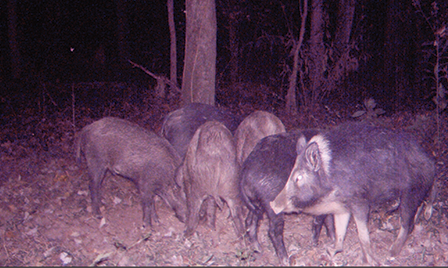Wild Pig
Wild Pig
Feral Hog Information:
Click on the following links to learn more:
- Wild Pig Overview
- Identification - Wild Pigs
- Wild Pig Damage Issues
- Potential Management Strategies
- Resources
- View all wildlife damage
Wild pigs (Sus scrofa) are widely considered to be the most destructive invasive species in the United States. They cause large amounts of agricultural damage, compete with native wildlife for resources, alter wildlife habitat, and threaten biological diversity. The United States Department of Agriculture (USDA) estimates that wild pigs cause $1.5 billion in damages and control costs in the United States each year, with at least $800 million being direct damage to agriculture. Due to their lack of predators, diverse diets, and quick reproductive abilities, they spread quickly, overtaking native species and their habitats. Wild pig establishment in the southeastern United States dates back to the 1500s. Early European explorers brought domestic pigs with them as livestock for their settlements. The historic practice of allowing pigs to range freely encouraged the spread and establishment of wild pigs throughout the southeastern United States. However, wild pig populations did not naturally expand into Kentucky. Wild pigs in Kentucky are the result of released domestic pigs and hybrids of domestic and Eurasian boars.
In Kentucky, wild pig populations generally arrive to an area in four ways:
1) domestic pigs escape into the wild,
2) pigs are intentionally released for hunting purposes, including translocated pigs that have always been wild,
3) domestic pigs are allowed to free range due to inadequate enclosures; and
4) pet potbellied pigs are abandoned.
Eurasian boars, also referred to as European wild hogs or Russian boars, differ in appearance from wild pigs. Eurasian boars typically have longer legs, a larger head, and a longer snout. The young are reddish brown with black longitudinal stripes. A mature animal is black in color. Eurasian boars have continuously growing tusks, in addition to multiple splits at the ends of the hair shafts and a mane from the neck to the base of the tail. There are no pure Eurasian boars in Kentucky.

Diet
The diet of wild pigs is classified as omnivorous, which means that they can—and will—eat almost any organic substance that is available. As a result, wild pigs can quickly establish themselves due to their ability to adapt to almost any food source. Vegetation dominates a pig’s diet, but animal prey is also common.
Wild pigs primarily feed by rooting, or turning over the topsoil in search of roots, tubers, and invertebrates. They use an incredible sense of smell to locate food. In addition to rooting, wild pigs will graze, scavenge, and predate. Prey can include deer fawns, turkey, quail, grouse, woodcock, amphibians, and various ground-nesting songbirds. If they are able to catch it, it is possible they will eat it. Seasonal changes in their diets greatly influence their selection of habitat. In the fall, for example, hard mast (e.g., acorns and hickory nuts) is a very common food item and causes them to compete directly with many native species that also rely on that food source. Likewise, wild pigs consume the eggs and chicks of groundnesting birds in the spring. Unfortunately, the feeding habits and associated behaviors of wild pigs often result in extensive damage to agriculture, ornamental plantings, native wildlife, and their habitat. It is this adaptability, coupled with continued illegal releases for hunting opportunities, that has resulted in rapidly emerging populations throughout the United States.
Social Structure
Multiple generations of related females, or sows, and piglets live in groups called sounders. By living in these sounders, pigs employ a safety-in-numbers strategy. Males leave the sounder around 16 months of age. These sub-adult males may associate in smaller familial groups, while mature males, or boars, tend to be more solitary in nature. Boars temporarily join sounders to breed.
Behavior
Wild pigs have excellent hearing and sense of smell, and they typically avoid human contact. When faced with danger, their general response is to run away. However, if cornered or defending their young, wild pigs can be aggressive and very dangerous.
